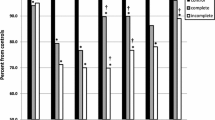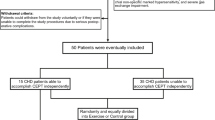Abstract
We assessed heart rate (HR) recovery following peak exercise before and after a 12-week cardiac rehabilitation program in 14 children, 12.1 ± 1.8 years of age, with repaired complex congenital heart disease (CHD; 11 with Fontan surgery) and impaired exercise performance. Exercise testing using bicycle ergometry was performed at baseline, after completion of the rehab program and 1.0 ± 0.2 years after the baseline test. These data were compared to HR recovery in 15 controls (age, 12.7 ± 2.4 years) with CHD (13 with Fontan surgery) with two serial exercise tests at an interval of 1.1± 0.3 years. There was no change in peak HR between the two serial tests in either group. Peak VO2 improved in the rehab group (26.3 ± 9.6 ml/kg/min at baseline vs 30.9 ± 9.6 ml/kg/min after rehab, p = 0.01) but remained unchanged in controls on serial testing. One-minute HR recovery (in beats per minute) improved significantly following completion of the rehab program (27 ± 15 at baseline vs 40 ± 23 after rehab, p = 0.01). Partial improvement in 1-minute HR recovery in the rehab group persisted 1 year later (1-minute HR recovery, 35 ± 19; p = 0.1 compared to baseline). There was no change in 1-minute HR recovery over time in the control group (37 ± 16 vs 40 ± 13, p = not significant). In conclusion, HR recovery following peak exercise improves in children with CHD after participation in a cardiac rehab program.
Similar content being viewed by others
References
Coats AJ, Adamopoulos S, Radaelli A, et al. (1992) Controlled trial of physical training in chronic heart failure. Exercise performance, hemodynamics, ventilation, and autonomic function. Circulation 85:2119–2131
Cole CR, Blackstone EH, Pashkow FJ, et al. (1999) Heart-rate recovery immediately after exercise as a predictor of mortality. N Engl J Med 341:1351–1357
Davos CH, Davlouros PA, Wensel R, et al. (2002) Global impairment of cardiac autonomic nervous activity late after repair of tetralogy of Fallot. Circulation 106:I69–I75
Davos CH, Francis DP, Leenarts MF, et al. (2003) Global impairment of cardiac autonomic nervous activity late after the Fontan operation. Circulation 108(Suppl 1):II180–II185
Imai K, Sato H, Hori M, et al. (1994) Vagally mediated heart rate recovery after exercise is accelerated in athletes but blunted in patients with chronic heart failure. J Am Coll Cardiol 24:1529–1535
Jouven X, Empana JP, Schwartz PJ, et al. (2005) Heart-rate profile during exercise as a predictor of sudden death. N Engl J Med 352:1951–1958
Legramante JM, Iellamo F, Massaro MC, et al. (2007) Effects of residential exercise training on heart rate recovery in coronary artery patients. Am J Physiol Heart Circ Physiol 292:H510–H515
Morise AP (2004) Heart rate recovery: predictor of risk today and target of therapy tomorrow? Circulation 110:2778–2780
Ohuchi H, Hamamichi Y, Hayashi T, et al. (2005) Post-exercise heart rate, blood pressure and oxygen uptake dynamics in pediatric patients with Fontan circulation. Comparison with patients after right ventricular outflow tract reconstruction. Int J Cardiol 101:129–136
Ohuchi H, Hasegawa S, Yasuda K, et al. (2001) Severely impaired cardiac autonomic nervous activity after the Fontan operation. Circulation 104:1513–1518
Ohuchi H, Ohashi H, Park J, et al. (2002) Abnormal postexercise cardiovascular recovery and its determinants in patients after right ventricular outflow tract reconstruction. Circulation 106:2819–2826
Ohuchi H, Suzuki H, Toyohara K, et al. (2000) Abnormal cardiac autonomic nervous activity after right ventricular outflow tract reconstruction. Circulation 102:2732–2738
Ohuchi H, Suzuki H, Yasuda K, et al. (2000) Heart rate recovery after exercise and cardiac autonomic nervous activity in children. Pediatr Res 47:329–335
Ohuchi H, Takasugi H, Ohashi H, et al. (2004) Abnormalities of neurohormonal and cardiac autonomic nervous activities relate poorly to functional status in Fontan patients. Circulation 110:2601–2608
Rahimi K, Thomas A, Adam M, et al. (2006) Implications of exercise test modality on modern prognostic markers in patients with known or suspected coronary artery disease: treadmill versus bicycle. Eur J Cardiovasc Prev Rehabil 13:45–50
Rhodes J, Curran TJ, Camil L, et al. (2005) Impact of cardiac rehabilitation on the exercise function of children with serious congenital heart disease. Pediatrics 116:1339–1345
Savin WM, Davidson DM, Haskell WL (1982) Autonomic contribution to heart rate recovery from exercise in humans. J Appl Physiol 53:1572–1575
Streuber SD, Amsterdam EA, Stebbins CL (2006) Heart rate recovery in heart failure patients after a 12-week cardiac rehabilitation program. Am J Cardiol 97:694–698
Acknowledgments
This study was supported by a grant from the Deborah Munroe Noonan Memorial Fund and by grant 5U01 HL068285 from the Pediatric Heart Network.
Author information
Authors and Affiliations
Corresponding author
Rights and permissions
About this article
Cite this article
Singh, T., Curran, T. & Rhodes, J. Cardiac Rehabilitation Improves Heart Rate Recovery Following Peak Exercise in Children with Repaired Congenital Heart Disease. Pediatr Cardiol 28, 276–279 (2007). https://doi.org/10.1007/s00246-006-0114-0
Received:
Accepted:
Published:
Issue Date:
DOI: https://doi.org/10.1007/s00246-006-0114-0




